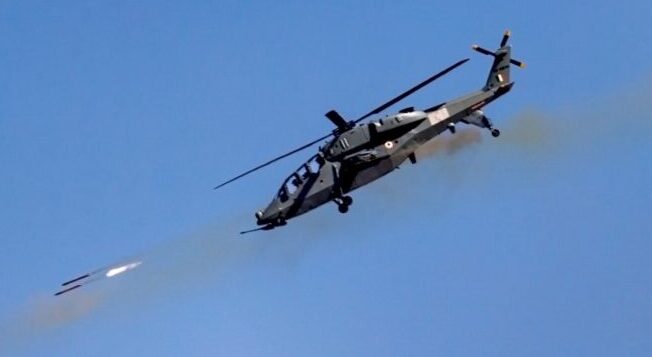Aviation
Govt Approves indigenously built 15 Light Combat Helicopters for Indian Defense

The Cabinet Committee on Security (CCS) met under the Chairmanship of Prime Minister Shri Narendra Modi on 30 March 2022 in New Delhi. The CCS has approved procurement of 15 Light Combat Helicopter (LCH) Limited Series Production at the cost of Rs. 3,887 Cr along with Infrastructure sanctions worth Rs. 377 Cr.
Light Combat Helicopter Limited Series Production (LSP) is an indigenously designed, developed and manufactured state of the art modern combat helicopter containing approx. 45% indigenous content by value which will progressively increase to more than 55% for SP Version.
[the_ad_placement id=”article-ad”]
This helicopter is equipped with requisite agility, maneuverability, extended range, high altitude performance and around-the-clock, all-weather combat capability to perform roles of Combat Search and Rescue (CSAR), Destruction of Enemy Air Defence (DEAD), Counter Insurgency (CI) operations, against slow moving aircraft and Remotely Piloted Aircraft (RPAs), high altitude bunker busting operations, Counter Insurgency operations in jungle and urban environments and support to ground forces and would be a potent platform to meet the operational requirements of Indian Air Force & Indian Army.
Why is China concerned about the Ka 52 being shot down?
[the_ad id=”11602″]
State of the art technologies and systems compatible with stealth features such as reduced Visual, Aural, Radar and IR signatures and crashworthiness features for better survivability have been integrated in LCH for deployment in combat roles catering to emerging needs for next 3 to 4 decades. Several key aviation technologies like Glass Cockpit and composite airframe structure have been indigenised. The future Series Production version will consist of further modern & indigenous systems.
Airbus inaugurates Hamburg’s fourth A320 Family production line
Under the Atmanirbhar Bharat Abhiyaan, India is continuously growing in its capability to indigenously design, develop and manufacture advanced cutting edge technologies and systems in the Defence Sector. The manufacturing of LCH by HAL will give a further push to Atmanirbhar Bharat initiative and boost indigenisation of defence production and the defence industry in the country. Production of LCH will reduce import dependence for Combat helicopters in the country. Light Combat Helicopters are already in the import embargo list. With its versatile features built in for combat missions, LCH has export capability.
Safran to manufacture engines for India’s 5th gen AMCA stealth fighter

Aviation
Boeing, Antonov to Collaborate on Defense Projects

– MOU represents Boeing’s commitment to work with Ukrainian industry
– Includes exploring opportunities for collaborating on in-country support of Unmanned Aerial Systems
A Memorandum of Understanding was signed today by Boeing and Antonov Company to investigate potential collaboration on defense-related projects.
“We’re happy to keep collaborating with the Antonov Company to help Ukraine’s economic development and expansion,” stated Ted Colbert, CEO and president of Boeing Defence, Space, & Security.
Airbus and the Antonov An-225: The Best Partnership:Click here
“This agreement demonstrates our ongoing efforts to find more opportunities to work with Ukrainian industry, which was underscored by our signing of the Ukrainian Defence Industry Compact earlier this year.”
The areas of potential collaboration identified in the agreement consist of training, logistical support and overhaul services for tactical Unmanned Aerial Systems utilized by the Ukrainian Armed Forces, which includes the ScanEagle. In addition, the companies will also explore opportunities for Antonov to provide engineering support to Boeing.
The six largest cargo aircraft ever built in the aviation industry:Click here
“A strong, innovative, and efficient defense industry is key to sustainable economic development and national security, and we are extremely excited to collaborate with Boeing,” said Ievhen Gavrylov, CEO of Antonov Company.
This agreement brings a whole new level of opportunity to implement the latest and most effective solutions – in addition to the possibility of future projects with Boeing in the aerospace and defense industry.”
-

 Travel1 week ago
Travel1 week agoAir India to Expand US Operations with Three New Routes After a Decade
-

 Travel2 weeks ago
Travel2 weeks agoWhy We Should Avoid These Stamps in a Passport
-

 Airlines1 month ago
Airlines1 month agoInvestigations Reveal Fake Chinese Titanium in Boeing and Airbus Jets
-

 Tech4 weeks ago
Tech4 weeks agoChina’s CATL Plans 1,800-Mile Electric Plane Launch by 2027
-

 Airport3 days ago
Airport3 days agoTop 10 Largest Airports in the World by Size
-

 Aerospace4 weeks ago
Aerospace4 weeks agoChina’s Fighter Jets Turn Wings into Autonomous Drones
-

 Airlines4 days ago
Airlines4 days agoAir India Rolls Out A350s for Delhi-New York JFK and Newark Routes
-

 Defence3 weeks ago
Defence3 weeks agoBoeing Enhances Chinook with New Engines and Block II Upgrades at $96 Million







